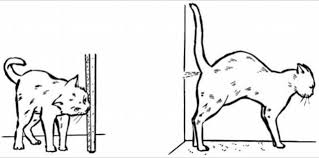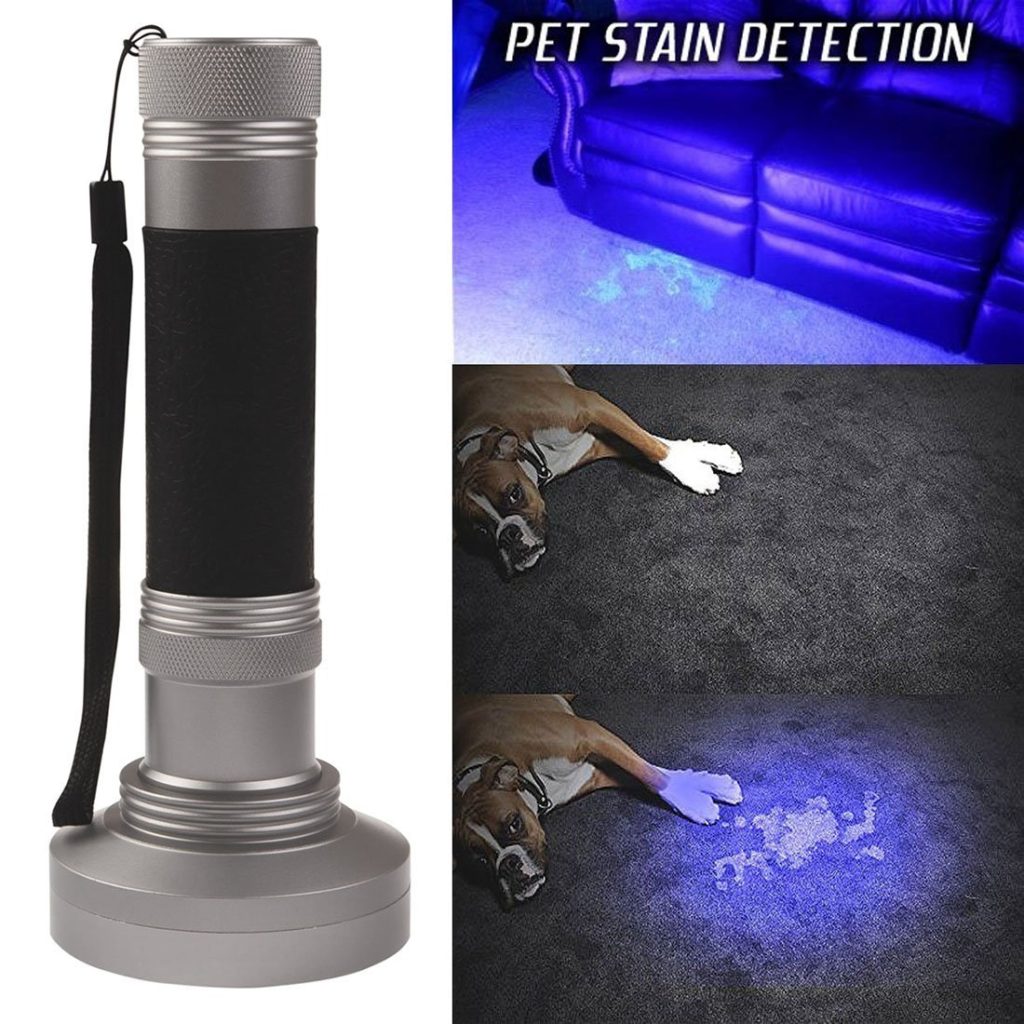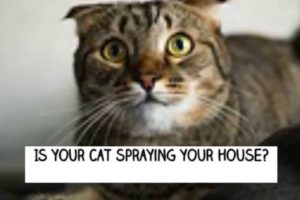How To Stop A Cat From Spraying Urine and Marking His Territory In The House
Is your cat marking every corner of your house by spraying urine? The smell of stale cat pee is certainly not a pleasant one, and neither is the sight of seeing your cat spray urine on your new couch, curtains and/or walls.
Territorial cats usually spray urine. The markings don’t make their habitat directly safer, but the cat can gather information through spraying. This helps the cat’s territory be safer.
In this article you will discover why cats spray urine, and how to stop this natural, but unwanted, behavior.
P.S. If you tried everything and still no success, we recommend you read this book.
What is cat urine spraying? And why does it happen?
It is important to first understand what this behavior is, and why cats do it, before you learn how to stop it.
 Marking territory with urine serves many purposes. It is a complex behavior, and out of scope of this article.
Marking territory with urine serves many purposes. It is a complex behavior, and out of scope of this article.
We will outline for you the minimum you should know about feline urine spraying behavior.
Urine markings are a form of communication. By spraying urine cats both send and gather information by smelling the markings of other cats around the area.
Are urine marks like borders? No. Cats, and especially the males, usually have a large territory. Territories can overlap. There are no actual borders that need to be protected. Through cat markings with urine cats can become aware of other cats without actually ever meeting each other face-to-face.
Insecure cats spray more. If a cat does not feel secure, she will spray more. The markings don’t make the area safer directly, but they help the cat gather information about other felines in and around their territory.
Why do cats spray over other cats’ markings? A marking helps a cat to know if other cats visit there. A cat actually expects other cats to spray over his spraying marks. A cat does not spray to show dominance or to claim a territory.
Why do cats keep spraying the same place? As long as the corner smells like urine, the cat wants to keep marking it to gather and send information to possible other cats.
Cats do not spray urine for revenge. Sometimes, scolding your cat can lead to spraying behavior. The cat thinks this may actually improve your relationship.
Other territorial markings of cats include clawing (in this article you can read more about cat clawing and how to stop it), and scenting objects with their cheeks and forehead.
-
Neuter your cat to stop urine marking
Cats spray for a multitude of reasons. The two primary reasons are to secure their territory and to find sexual partners. Helping a cat feeling more secure around his territory is a complex process. But lowering your cats sexual appetite is however an easy surgical procedure, carried out daily by vets all around the globe.
When will a cat stop spraying after being neutered? That depends on many things, but here are some pointers:
- The vast majority of cats will stop spraying immediately after neutering.
- 1 to 4 weeks after neutering.
- Only when additional measures are taken. (see below)
For the majority of people, neutering Mr. Mittens will be enough to stop him from spraying. If your cat keeps spraying after he has been neutered, keep on reading below.
Note:
Your male cat will not stop spraying urine without neutering. Urine marking is natural behavior. Testosterone is the main cause of this. Testosterone is produced in the testicles.
-
Find other causes of your cat´s urine spraying behavior
Sometimes cats don´t stop spraying immediately after being neutered. It is possible you only need to wait a little while longer, about 1 to 4 weeks. Or finding sexual partners was not the sole reason of your feline´s behavior We list a few common possible causes of urine marking by cats.
Multi-cat household
Cats not getting along with each other is a common problem. A cat can be bullied by another cat. An unsettled hierarchy in the household can be a cause. The cat´s territory, or access to food and water is being threatened.
Having more resources in the house usually helps. Add more litter boxes in multiple locations. More food and water bowls can work wonders too.
- Other (indoor) cats.Since urine marking is a form of communication between cats, most likely it is caused by other cats, even if you have a single indoor cat.Having enough napping locations is also important, as is vertical territory (Link to article) Make sure climbing spots have no dead-ends where cats can be trapped by other pets. A great help for multiple cat owners is the book cat vs vst (aff lons)
- Outdoor cats Common problems can be your cat going outside and spraying urine upon returning home. Your cat seeing other cats through a window, or smelling other cats´ urine marking through the wall. Sometimes this can be a cause of aggressiveness in cats.Keep other cats out of the yard. Clean the cat urine outside your house. Block the view that is causing the problems. Blinds or sticky films work well, or otherwise blockingthe window view. Spending more time interacting positively with your cat helps them to build confidence in their surroundings.
- Tensions with an owner. A common cause of urine spraying. The cat experiences a feeling of insecurity about his environment.Do not yell or punish your cat for his behavioral problems, including urine marking. Give the cat as much freedom as possible. Increase the amount of time interacting and building trust with your cat through playing, petting, talking, brushing and other positive activities. Adding climbing opportunities can also help.
Changes are a common cause of stress in cats
Stress in cats is the most common reason of spraying urine in neutered cats. We listed a few common causes of stressful situations, and how to remedy them.
- A new baby in the house, or a toddler starting to crawl or walk.
It may be necessary to modify the environment. Create secure, elevated surfaces. Give your cat more attention, or make at least sure that it´s not getting less attention than before. Feeding your cat while the baby is nearby is a good way of getting accustomed for the cat. It´s important to teach toddlers how to interact in a positive way with cats, and how to pet cats the right way. - New person in the household, or new frequent visitors.
The cat and the person are not getting along. The cat can be afraid of the person. People can be too loud, or maybe they don´t like cats. Some people are afraid of cats. Get the other person involved in feeding, playing and petting. Not everyone knows cat behavior basics. Sometimes explaining cat behavior basics and signs of aggression and dislike to the person is the solution. - Changes in the cat’s territory.
Almost any change in the cat’s environment can cause stress. Some cats are more prone to stress than others. This can even be something as small as adding new furniture, or displacing coats and jackets. Moving houses often is a trigger of stress, especially if everything is new inside. To counter this, make changes slowly and gradually. Make sure you have enough playtime with your pet. Spraying furniture with pheromones can also do the trick, as does adding more climbing opportunities.
- Changes in daily schedule.
Often a change in the cat’s feeding schedule is the culprit. If you need to make changes to your cats’ routine, try do so gradually.
- Other changes.
New pets or scents in the house, a new food brand or new sounds can also attribute to significantly higher stress-levels. Try to get your cat slowly accustomed by making these changes gradually, if possible. If not, make sure you give your cat plenty of playing time and positive attention.
These are just a few causes of stress in cats. Other stress they may experience can also be a cause for urine spraying. Due to stress, the cat feels less confident and secure in his territory. By urine marking, the cat is trying to secure his territory. Often there are multiple causes that make a cat build up stress.
Certain medical conditions can also be a cause for spraying behavior. Cats can have medical conditions that interfere with their hormonal balance. If the cat is in pain or experience’s discomfort, this can also lead to stress. Bring you pet to the vet as soon as you have the slightest hint of health problems, especially when you have done and tried everything to stop your cat from spraying urine, without success.
-
Thoroughly clean urine from spraying locations.
Cats re-spray their old marks. This helps them keep their markings updated. Other cats spray over markings of other cats. This helps the cats understand who is in their territory. If the cat smells that the spot has been previously marked, it will spray urine.
Cleaning cat urine with everyday cleaning supplies is not enough to completely get rid of the cat urine smell. Even if it smells clean to you, your cat will still be able to smell the mark. A cat’s nose is far more sensitive than yours. When the cat smells the mark, the urge arises to spray there again.
How to find cat urine?
You usually find cat urine either by seeing your cat spray somewhere, or by smelling it. So you know where to clean, right? Unfortunately this is not the case.
The scent of cat urine can linger for as long as a few months. You have to clean every single spot your cat has urine marked during this period. You can try and remember all spots that your cat uses to spray, or write them down. Even then it is still possible to miss spraying locations. Cats have a much more sensitive nose than you. It is easy to miss a spot.
A simple black-light LED flashlight is your solution. Certain substances light up under black light, including cat urine.
You can usually buy these flashlights in hardware stores, but it’s often cheaper, easier and quicker to do so online. If you shine your black light over area’s where cats have sprayed, a grayish/yellowish glow will appear. This is the area that you need to clean very thoroughly with a specialized cat urine remover.

How to clean cat urine?
Use a specialized cleaning detergent that is specifically made for removing cat urine. These cleaning supplies do not mask the smell, but bind to the molecules that cause it. This completely eliminates cat urine and consequently, the smell.
Specialized cleaning supplies can be bought at pet stores, some hardware stores and online here.
Most cleaning detergents for cat urine are quick and easy to use, with a simple “spray on and let dry” mechanism. Some require a bit more instruction, so always check the label before use.
-
Make new associations with the spraying location
Giving a new purpose to the location that is being marked with urine is the next step in the process of stopping cats from spraying. In their natural habitat, cats do not spray certain locations.
E.g. Cats do not spray areas where they sleep or hunt.
There are several ways to make these changes in your household, we’ll list a few. If you already tried below options without (lasting) success, we advise you to read this book.
Tips:
- Place a water bowl in the vicinity of the markings. Cats to dot spray urine where they drink.
- Spray the location with cat pheromones. Pheromones are scents that cats leave behind by rubbing against objects. You can buy these pheromones in a spray solution. If the cat gets the scent that a location has been marked by rubbing, it will registered this location as “marked” and therefore not spray it.
- Place a scratching post near the markings. Cats not only scratch to keep their claws in good shape. Scratching serves a few purposes. By scratching, cats leave behind scents from their paws. Scratching marks are also a visually indicator of the presences of felines. If the cat scratches near the place where urine spraying occurred, the cat will no longer need to urinate there. Territorial urges have already been met.
- Play with your cat near the urine marking location. Playing and hunting are essentially equal to cats. Cats do not spray urine where they hunt, as this would alert their prey. We can simulate this behavior by playing with your cat with an interactive toy for 10 to 15 minutes around the spot. Have a few of these sessions daily. It takes about a week to see a noticeable improvement. Don’t forget to play regularly with you cat after that!
- Feed your cat near the spraying location. This behavior is related to hunting. If you provide food at set times and places, make the spraying location a feeding place instead. If you free feed your cat , leave some food at the spot that used to be sprayed.
- Place your cat’s bed near the spraying location. Sometimes placing a cardboard box for napping is enough. A cat’s sleeping spot must be a safe and secure place. A cat would not spray around there, because he does not want other cats to be alerted of his whereabouts.
Important: While you are helping your cat to stop spraying his old location, your cat start making new ones somewhere else. This is often caused by the cat not feeling secure in his habitat.
-
Distract your cat before spraying occurs.
You are probably aware of the signs and body language a cat shows before he is about to leave his spray marks. Common indicators are:
- Positioning of the hind legs against the soon-to-be-sprayed spot
- Treading with his front paws
- Raising of the tail
When you notice your cat is going to spray urine on your wall, you might want to stop that from happening. Distract the cat by refocusing his attention in a positive manner.
Several positive ways of grabbing your pet’s attention:
Call your cat
First, make sure your cat responds. Keep calling and pet him, of give him a treat if he responds well. You can also pet your cat, to associate not spraying with positive attention..
Bribe with treats
If you want to get a cats attention, a sure way is to rattle or open a pack of their favorite treats. Food is more interesting than spraying.
Throw in a hunting opportunity
Dingle a thread or throw a toy in your feline’s direction. If it contains catnip, that’s often even more effective. Keep playing for a couple of minutes with your pet afterwards.
Clicker training
Clicker training is a good way of training and correcting behavior. It’s easier because you don’t need to have a toys or treats near you at all times. In these cases, clicker training is a very handy tool.
Note: It is important that you apply above tips and tricks only if you get your cat’s attention before the urine spraying. If you apply these tips after the spraying, you will only reinforce the spraying behavior by rewarding your cat with positive attention.
-
Do not punish your cat after spraying urine.
It’s not fun when your cat marks your couch with urine. But punishing your cat will only make him spray more. Neutered cats most often spray because of stress. Punishing your cat either through physical punishment or by yelling will not stop you cat from spraying urine, but will only increase the behavior. Cats that are neutered commonly spray due to stress. Punishment increases stress greatly.
It is best to ignore your cat completely when he marks. Ignore the bad behavior, and reward the good.
Clean up after your cat with the methods described above. Don’t pay any attention to your cat while cleaning. Don’t call him, lecturing him, or give any attention in any way. Clean the area and next time prevent your cat from spraying, before it happens.
-
Provide a safe, secure and calm living area for your cat.
The gist of this article is that cats most commonly spray urine because of stress, if hormonal factors are out of the question. It is the best interest in both of you to get rid or minimize stress.. If you manage to reduce stress, your cat will not spray urine any more.
If you still have problems with your cat’s spraying behavior, invest in this book. It has more detailed information on cat spraying and how to stop it.
Thanks for reading, and if you have any comments, suggestions or questions, please leave them in the comments below. J




